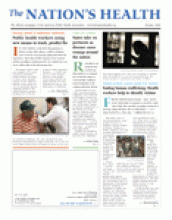From radon to mold to lead-based paint, unhealthy housing conditions can take a significant and sometimes irreversible toll on the health and safety of a home’s occupants. Asthma, lead poisoning, injuries and cancer are some of the health and safety hazards associated with unhealthy housing, and few Americans are free from risk.
A 2009 survey from the National Center for Healthy Housing in Columbia, Md., found that 67 percent of families in the United States live in homes with at least one major health risk.
To ensure that healthy and safe housing is accessible to families of all income levels, APHA Press in October released “Healthy and Safe Homes: Research, Practice and Policy.” Incorporating the expertise of a diverse field of public health professionals, scientists, housing advocates and policy leaders, the book fully explains the substandard housing issues that undermine Americans’ health and safety and offers holistic, strategic and long-term solutions to the problems.

The places in which people live are “critical determinants of health,” said APHA member Rebecca Morley, MSPP, executive director of the National Center for Healthy Housing and the book’s lead editor. But each individual home comes with a complex mix of interconnected issues.
“Over the last century, people have been trained to become more specialized, and as a result we have had a gap created between the housing world and the health world and the environmental world,” said Morley, who stressed the need to bring the three areas together so that they can be mutually supportive and not mutually exclusive.
As a necessary step to advancing healthier housing, the book promotes integrating a number of fields that typically operate in separate silos, such as public health, urban planning, air and water quality, building science, home safety and social policy. To achieve that goal, 19 experts share their knowledge in the book’s 10 chapters.
“The real beauty of this is that the authors were selected for their ability to not only know the science and be cutting edge, but also to take the information and translate it into useful and practical tips for other professionals to use in their efforts to keep the public safe and healthy,” co-editor Angela Mickalide, PhD, CHES, director of education and outreach at the Home Safety Council and an APHA member, told The Nation’s Health.
The book is a follow-up to the U.S. surgeon general’s 2009 “Call to Action to Promote Healthy Homes,” said co-editor Karin Mack, PhD, a senior behavioral scientist in the Centers for Disease Control and Prevention’s National Center for Injury Prevention and Control and an APHA member. In two of the book’s chapters, the CDC center explores a multifaceted approach to injury prevention that combines behavioral change, education, installation and maintenance of safety devices and adherence to building codes and regulations.
APHA Annual Meeting-goers will be able to attend a book signing with some of the authors from 2 p.m. to 3 p.m. on Nov. 8 in the Everything APHA section of the meeting’s Public Health Expo.
To buy “Healthy and Safe Homes: Research, Practice and Policy,” visit www.aphabookstore.org. For more information, e-mail apha{at}pbd.com.
- Copyright The Nation’s Health, American Public Health Association












